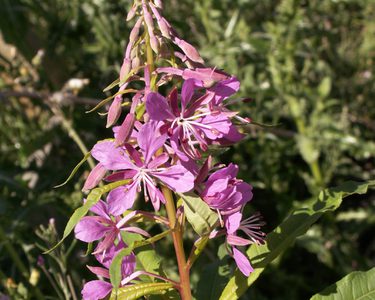Rosebay willowherb

Other names
fireweed
Latin names
Chamerion angustifolium (L.) Holub, (Chamaenerion angustifolium, Epilobium angustifolium)
Weed Type
Perennial Broad-leaved Weeds
Where would I find Rosebay willowherb?
Rosebay willowherb is an erect, rhizomatous, perennial, native on waste ground, embankments, rocky places, mountain scree and open woodland throughout the UK. It is recorded up to 1,850 ft in Britain. Formerly uncommon it became abundant in bombsites, burned areas and forest clearings. On the Isle of Wight, it suddenly appeared in abundance on an area of woodland destroyed by fire in 1909. Rosebay willowherb is favoured by conditions after woodland clearance and in the early stages of coppicing but growth and flowering become restricted as the tree canopy develops again. In reclaimed bogs in Ireland it is an important early colonizer but disappears as the vegetation matures. In Scotland, rosebay willowherb was a frequent colonist in unsown set-aside land but was less common where a cover crop had been sown. Rosebay willowherb can be a problem weed in perennial crops.
Rosebay willowherb is tolerant of acid and alkaline soils but does not grow in soils with poor mineral nutrition. It is usually absent from waterlogged soil but grows in wet conditions around ponds as well as on dry sandy heaths and chalk downs. Rosebay willowherb tolerates shade and a broad range of climatic conditions.
It is suspected by some botanists that the sudden spread of rosebay willowherb was due to the introduction of the North American form that has 72 chromosomes while the native form has 36. Considerable intraspecific variation has been observed in rosebay willowherb in North America where it is eaten by deer and range cattle. It was also used as a food plant by the native Indians. The nectar is important for hive bees in certain localities.
Biology
Rosebay willowherb flowers from June to September. Although plants are self-compatible, the anthers dehisce long before the stigma opens ensuring cross-pollination occurs, predominantly by insects. The wind blown seeds are dispersed from late July-August. The average number of seeds per capsule is 300-500 and the number per plant is 80,000.
Seed germination is more successful in a moist atmosphere. Seeds germinate best at or near the soil surface. Burial below 2 mm markedly reduces seed germination. Germination will occur in darkness depending on the temperature but is increased by light. Seed germination can occur at any time of year provided conditions are favourable. In Europe, germination in the field happens mainly in late summer. In the UK, seeds that do not germinate in the autumn after shedding, germinate the following spring. Seedlings are unlikely to develop within mature stands of rosebay willowherb.
Seedlings initially form a rosette of leaves. Once established seedlings soon send out shallow underground stems. The main root and its strongest branches become thick and fleshy and spread laterally for several feet. As the internodes elongate on the main shoot, side shoots may begin to form and adventitious buds develop on the roots. It is these buds that form the vegetative means of spread that result in large clonal patches. New aerial shoots arise each spring from buds formed late in the previous year. Root growth can be initiated at 4.5°C and commonly precedes shoot elongation. Plants often flower in their first year.
Does Rosebay willowherb spread easily?
Seeds remain viable for 18 months but do not form a persistent seedbank. Seeds lose viability after 18 months dry storage at room temperature but persist for more than 2 years stored dry at 5°C.
Seeds have a plume of hairs and are wind dispersed. It has been estimated that 20 to 50% of seeds may be carried 100 m by the wind and some could potentially travel over 100 km. Rosebay willowherb also spreads by the horizontal roots on which adventitious buds develop. The roots extend by up to 1 m per year and spread well beyond the aerial stems. Expansion is limited where soil fertility has declined.
Established colonies of rosebay willowherb may persist for long periods. On sand dunes in Holland, stands 35 years old have been identified. Fragments of root can produce adventitious buds within 3 weeks. Longer fragments are more successful at regeneration and sections shorter than 8 cm are unlikely to produce shoots. Even pieces of 20-year old roots can produce buds following soil disturbance.
How to manage Rosebay willowherb organically
Rosebay willowherb is susceptible to shoot loss from trampling, cutting, burning and grazing. Liming is said to inhibit establishment.
A wide variety of phytophagus insects are associated with rosebay willowherb in Britain.